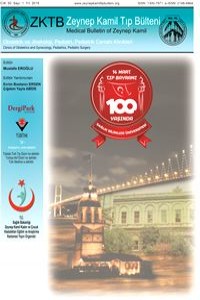Vajinal Doğum Sonrası Plasentanın Kendiliğinden Ayrılma Zamanının ve Bu Süreyi Etkileyen Faktörlerin Belirlenmesi
Abstract
Amaç:
Bu çalışmanın amacı, vajinal doğum sonrası plasentanın kendiliğinden ayrılma
zamanını ve bu süreyi etkileyen faktörleri belirlemektir.
Yöntem:
Çalışmamıza İstanbul Dr. Lütfi Kırdar Kartal Eğitim ve
Araştırma Hastanesi Kadın Hastalıkları ve Doğum kliniğine 01.03.2016-01.01.2017
tarihleri arasında vajinal doğum için başvuran 198 hasta dahil edildi. Vajinal
doğumu takiben plasentanın kendiliğinden ayrılması beklendi ve 5’er dakika
aralıklarla kontrol edildi.
Bulgular:
Plasentanın ayrılma zamanı 11,69±6,09 dakika olarak tespit edildi. İndüksiyon
alan ve daha önce doğum yapmış hastalarda plasenta
ayrılma zamanının kısaldığı görüldü.
Hastaların %96’sının plasentasının ilk 20 dakika içerisinde ayrıldığı izlendi.
198 hastanın 5’inde plasenta 30 dakika içerisinde kendiliğinden ayrılmadı ve
elle halas edildi.
Sonuç:
Bu çalışmada plasentanın kendiliğinden ayrılma süresi 10-15 dk. aralığında
izlendi. Plasentanın kendiliğinden ayrılması için eşik değerin 20 dk olarak
tespit edilebileceği düşünüldü. İndüksiyon almak ve daha önce doğum yapmakta bu
süreyi kısaltan faktörler olarak tespit edildi.
Keywords
References
- Hibbard BM. Obstetics in general practice. The third stage of labour. Br Med J 1964; 5396:1485.
- Khan KS, Wojdyla D, Say L, et al. WHO analysis of causes of maternal death: a systematic review. Lancet 2006; 367: 1066-10.
- Combs CA, Laros RK. Jr. Prolonged third stage of labor: Morbidity and risk factors. ObstetGynecol 1991; 77(6): 863-7.
- Dombrowski MP, Bottoms SF, Saleh AA, Hurd WW, Romero R. Third satage of labor analysis of duration and clinical practice. Am J ObstetGynecol 1995; 172:1279-84.
- Yuen PM , Chan NST , Yim SF , Chang AMZ . A randomised double blind comparison of Syntometrine and Syntocinon in the management of the third stage labor. BJOG 1995; 102(5): 377-80.
- Taebi M, Abedzadeh M.K, Saberi F, Sadat Z. Theduration of thethirdstage of laborandrelatedfactors. Iran J NursMidwiferyRes. 2012 Feb; 17(2 Suppl1): S76–S79
- Panpaprai P, Boriboonhirunsarn D. Risk factors of retainedplacenta in SirirajHospital. J MedAssocThai. 2007;90(2 Suppl1):1293–7.
- Zhou W, Nielsen GL, Larsen H, Olsen J. Inducedabortionandplacentacomplications in thesubsequentpregnancy. ActaObstetGynecolScand. 2001;80(12):1115–20
- Frolova AI, Stout MJ, Tuuli MG, López JD, Macones GA, Cahill AG. Duration of the Third Stage of Laborand Risk of PostpartumHemorrhage.nObstetGynecol. 2016 May;127(5):951-6.
- Lurie S, Gomel A, Adan O, Ginath S, Rotmensch S, Glezerman M. TheDuration of the Third Stage of Labor Is Subject to the Location of Placental Implantation. Gynecol Obstet Invest 2003;56:14–16 .
- New Zealand College of Midwives. Third stage management practices of midwife lead maternity carers: an analysis of the New Zealand College of Midwives Midwifery Database Information 2004 -2008. Christchurch: New Zealand College of Midwives, 2009.
- Begley CM, Gyte CML, Murphy DJ, Devane D, McDonald SJ, McGuire W. Active versus expectant management for women in the third stage of labor, Cochrane Database Syst Rev Issue 7, 2010.
Determining the Time of Spontaneous Separation of Placenta and the Factors Affecting This Time After Vaginal Delivery
Abstract
Objective: The purpose of this study is to
determine the timing of spontaneous separation of placenta after vaginal
delivery and the factors affecting this time.
Methods: Between 01.03.2016-01.01.2017 in the department of
Obstetrics and Gynecology in İstanbul Dr. Lütfi Kırdar Kartal Education and
Research Hospital.198 patients referred for
vaginal delivery were included in our study. Following vaginal delivery,
the placenta was expected to be spontaneously separated and checked at
intervals of 5 minutes
Results: The
separation time of the placenta was determined to be 11,69±6,09 minutes. It has
been observed that the time for placental separation
in induction-receiving and previously delivered patients is shortened. The
placenta of 96% of the patients left within the first 20 minutes. In 5 of 198
patients the placenta did not spontaneously separate within 30 minutes and was
taken by hand
Conclusion:
In this study,
the spontaneous separation time of the placenta was observed at intervals of
10-15 minutes. It was thought that 20 minutes should be determined as the
threshold value for the spontaneous separation of the placenta. Taking
induction and previously giving birth has been identified as a shortening
factor
Keywords
References
- Hibbard BM. Obstetics in general practice. The third stage of labour. Br Med J 1964; 5396:1485.
- Khan KS, Wojdyla D, Say L, et al. WHO analysis of causes of maternal death: a systematic review. Lancet 2006; 367: 1066-10.
- Combs CA, Laros RK. Jr. Prolonged third stage of labor: Morbidity and risk factors. ObstetGynecol 1991; 77(6): 863-7.
- Dombrowski MP, Bottoms SF, Saleh AA, Hurd WW, Romero R. Third satage of labor analysis of duration and clinical practice. Am J ObstetGynecol 1995; 172:1279-84.
- Yuen PM , Chan NST , Yim SF , Chang AMZ . A randomised double blind comparison of Syntometrine and Syntocinon in the management of the third stage labor. BJOG 1995; 102(5): 377-80.
- Taebi M, Abedzadeh M.K, Saberi F, Sadat Z. Theduration of thethirdstage of laborandrelatedfactors. Iran J NursMidwiferyRes. 2012 Feb; 17(2 Suppl1): S76–S79
- Panpaprai P, Boriboonhirunsarn D. Risk factors of retainedplacenta in SirirajHospital. J MedAssocThai. 2007;90(2 Suppl1):1293–7.
- Zhou W, Nielsen GL, Larsen H, Olsen J. Inducedabortionandplacentacomplications in thesubsequentpregnancy. ActaObstetGynecolScand. 2001;80(12):1115–20
- Frolova AI, Stout MJ, Tuuli MG, López JD, Macones GA, Cahill AG. Duration of the Third Stage of Laborand Risk of PostpartumHemorrhage.nObstetGynecol. 2016 May;127(5):951-6.
- Lurie S, Gomel A, Adan O, Ginath S, Rotmensch S, Glezerman M. TheDuration of the Third Stage of Labor Is Subject to the Location of Placental Implantation. Gynecol Obstet Invest 2003;56:14–16 .
- New Zealand College of Midwives. Third stage management practices of midwife lead maternity carers: an analysis of the New Zealand College of Midwives Midwifery Database Information 2004 -2008. Christchurch: New Zealand College of Midwives, 2009.
- Begley CM, Gyte CML, Murphy DJ, Devane D, McDonald SJ, McGuire W. Active versus expectant management for women in the third stage of labor, Cochrane Database Syst Rev Issue 7, 2010.
Details
| Primary Language | Turkish |
|---|---|
| Subjects | Health Care Administration |
| Journal Section | Original Research |
| Authors | |
| Publication Date | March 14, 2019 |
| Published in Issue | Year 2019 Volume: 50 Issue: 1 |


